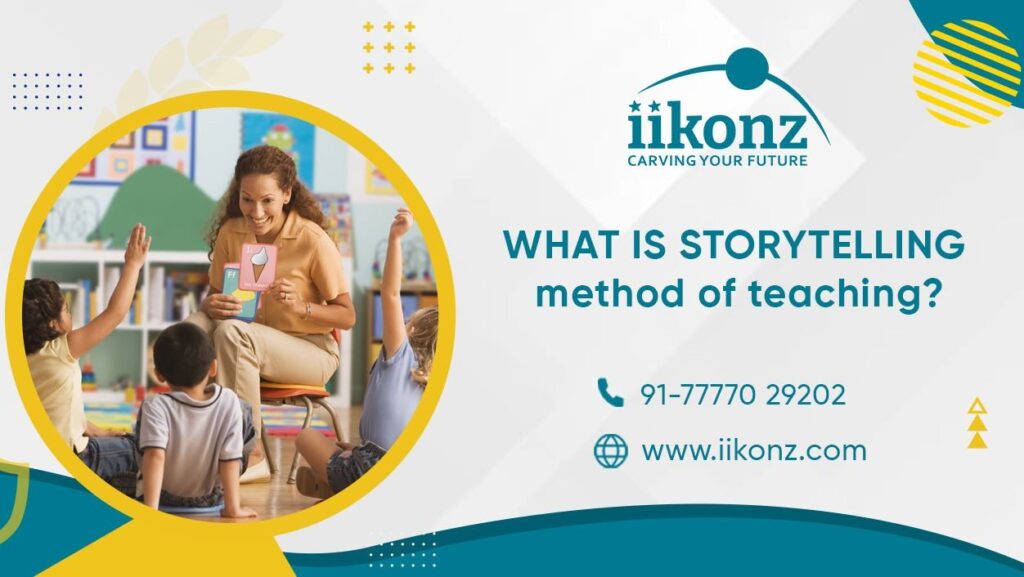Storytelling is a great way for parents and teachers to connect with and talk to kids. Our forefathers used it to share beautiful myths, national traditions, value systems, expertise, and moral beliefs. It is a powerful tool. Teachers who know how to tell stories well can create an impact on the lives of their students. The power of words can have a significant impact on kids’ lives. Stories can get kids interested in learning new things, spark their imaginations, and aid them in comprehending the world around them better.
Everyone does it, and people have done it for as long as they can remember. We tell stories because it helps us get to know each other better. Educators tell stories. Think about all the times you’ve had to share a story to explain something or help your students better grasp it. You might not even realize it, but you already use stories as a way to teach. Children who hear a lot of stories have a solid understanding of the human spirit. They are likely to develop strong empathy and a sense of accountability toward others.
Why is telling stories an effective way to teach?
Research shows that telling stories is a way to help students learn more about the world around them. It also helps kids imagine what it would be like to be in the same situation as the storyteller. Students must be able to tell stories about events in the order they happened. It is a common educational standard. Storytelling and listening to stories are vital aspects of a child’s learning to read. Stories make learning fun and also aid students in comprehending what they are learning better.
Effective story-telling methods for children:
People know that telling stories is among the most effective ways to teach. The key benefits of storytelling are high motivation and active engagement, a boost in creativity, cooperation between children, a deeper understanding of a subject, and a longer attention span.
There are many ways you can use stories in the classroom. Here are some suggestions.
To begin a fresh topic:
A great way to start a new topic is with a story. It’s like a way to break the ice. It can help students understand a subject and get involved in it before you even start teaching it. Actively use what they already know by telling a story about the fresh topic you’re about to discuss. If you can’t really think of one on your own, you look for one that fits your topic on the Web.
A reader’s theater is another way to get students interested in a new topic by telling a story. Just turn the subject into a script that the students can perform.
To Illustrate a Concept
Not everyone finds it easy to remember concepts. That’s when stories can come to the rescue. In the world of video content, smart phones, and podcasts that we live in now, storytelling can be a good way to explain a hard idea. You can use videos, photos, apps, and audio to assist students’ recall in a more inventive and interesting way with digital storytelling.
Digital storytelling isn’t the only way to explain a complicated idea. Images and illustrations can also be employed to tell a story. Show the students a series of images or drawings that show a certain idea and have them write down the story.
Take Your Kids to a Different World:
When a story is told well, it must create a film in a child’s mind and take them to a magical world. Use simple words that are easy to visualize instead of words that are hard to understand. The best way to get kids interested is to use words that take them to another place and spark their imaginations. When teachers use visual storytelling, kids can recollect and keep in mind bigger chunks of information for longer periods of time. Tell your story in a way that allows kids to listen, see, smell, and perceive what you’re trying to say.
To understand a subject better:
Telling a story about a subject can make it more interesting. It can make it more interesting and maybe get students interested enough to want to learn more. History is filled with people from the past, and you can bring them to life through stories. Math can be hard for a lot of students to comprehend, but they can make it more understandable by making up their own word problems. Storytelling is an effective tool that can make any lesson into an exciting challenge.
Move around to improve attention:
Move around to improve attention: As the storyteller, you can use your hands, feet, legs, and head to create images with your body. In the same way, you can have the students move during some portions of the story. It will help them remember what you said and keep their attention on what you’re saying.
Dramatic pauses can be utilized to get people to think:
People often talk faster than the brain can understand. If you pause at key points in the story, you give your students a chance to think about the information you just gave them. Don’t be afraid to take a break, especially when things are getting tense.
Dramatic pauses, or “cliffhangers,” are used in popular television series to draw viewers back into the plot. When it appears that the problem can’t be solved, you should pause and give your audience time to think of a solution.
Make sure your story solves a problem:
Every story has a main point or theme. When you’re able to tell a story that addresses a problem, it’s more likely that the story will have a deeper meaning when it’s used to resolve an issue in real life.
Keep your narrative concise and straight to the point:
Keep the story short and to the point: children already have a short attention span, so if you tell them long stories, they will lose interest quickly. One nice way to tell a story would be to keep it short and clear so that the audience stays interested until the end. The goal of a storyteller is to give the listener valuable knowledge and information in a short period of time so that they can remember the moral of the story for a longer time.
Make a “what’s going to happen next?” moment:
Kids who really like listening to stories put all of their thoughts into them. So, suspense is an important part of any plotline because it makes the audience anticipate what will happen next. With plot twists, kids can keep listening to the storyteller. They are intrigued by the story’s climax and ending. So, so one great way for a teacher to tell a story is to put the audience right in the middle of the action and then go back and explain what happened. Also, building suspense is a great way to help a child develop their thinking skills. Due to this important part, kids think about different possible outcomes, come up with ideas and concepts, and understand the distinction between right and wrong behavior.
Always Finish on a happy note:
A good story always starts with a problem and ends with a happy ending. End a story with something positive and memorable that kids will always remember. A happy ending warms kids’ hearts and makes them want to face problems, setbacks, and challenges. A story should make a good impression on their hearts, not a bad one. A reward is an enjoyable end. A story should end on a happy note that encourages kids to act in life, even when it seems hard. This makes children want to tell their friends or family members about the story and talk about what they learned and how it made them feel. A happy ending usually makes the people who hear it feel good about themselves and proud of what they have done.
Make your conclusion memorable by emphasizing something important:
The last point your students will hear is the climax. Put at the end the points and/or precepts you think are most crucial. If waiting until the end doesn’t sound right, just add them at the end to emphasize the point.
If you can render the last sentence a complete thought, that’s even better. Use alliteration, repetition of words, or a cadence that sounds like a song to help people remember it.
Conclusion:
Storytelling is a great way to get kids to feel things. Through stories, kids learn important facts and lessons about how to live in this world. It is a great means for a child to grow emotionally, mentally, and psychologically. Children acquire knowledge of history, new ideas, and different points of view from all over the world by listening to stories.
So, as a teacher or parent, if you wish to instruct them in good values and inspire them with stories, you need to use effective and efficient storytelling techniques. You’ll be a great storyteller if you use the techniques we have listed above. Click here to connect with us for more details.

